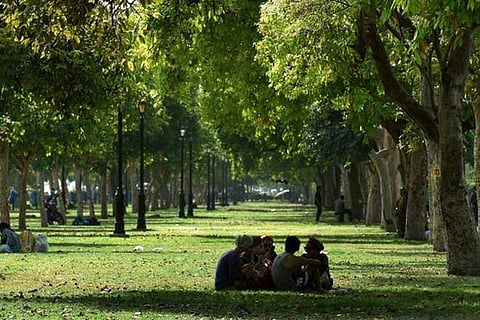

NEW DELHI: After opening of the Jama Masjid metro station, work has begun on the reconstruction of Netaji Subhash Park in old Delhi, which was inaugurated originally by the then Prince of Wales as the All-India King Edward Memorial in 1922.
The lush green park, spread over around five acres, in the vicinity of the Red Fort and neighbouring Jama Masjid, was dismantled when the metro's Violet Line was being extended till Kashmere Gate.
An impressive ensemble statue of Netaji Subhas Chandra Bose flanked by his INA compatriots was removed to carry out tunnelling and other civil work. It has been restored in the municipal park, sitting on a new pedestal.
"Work is currently underway to rebuild the park and we will hold a meeting with the DMRC authorities to get a timeline about its completion," said North Delhi Mayor Preety Agarwal.
The park, which falls under the North Delhi Municipal Corporation (NDMC), today may have become a symbol of Independence and patriotic fervour, but it originally stood as a monument to British monarch King Edward VII, whose imposing equestrian statue was the centrepiece of the memorial.
Eighty-four-year-old author and photojournalist Dhruva N Chaudhuri still fondly recalls the blooming gardens and the glory of the 'Edward Park' as it came to be known in local parlance, and rues its "faded glory" and the change of its name and character to lend it a "post-colonial identity".
The statue was unveiled in mid-1970s by then Vice President B D Jatti and was shifted to carry out metro construction work a few years ago.
"My father used to take me there for walks and it was a magnificent garden, well-maintained all time of the year. The statue of King Edward VII was perhaps the finest equestrian statues in India, after that of General Outram in Calcutta.
It's a pity they removed it.
"History should not be judged. Colonial rule is part of India's history and there is no reason to be feel embarrassed about it. The statue was also a great work of art and craftsmanship that the current generation should have seen, and that alone should have merited its preservation, at least in a museum," he told PTI.
Chaudhuri, son of legendary author Nirad C Chaudhuri, says the the steps leading to the giant pedestal offered the "best view of the Jama Masjid".
The five-tonne statue of heroic size, shows the king on horseback, wearing the full-dress uniform of a Field Marshal and holding his plumed hat in his left hand.
The majestic statue was designed by Sir Thomas Brock, the designer of the Queen Victoria Memorial opposite Buckingham Palace, London, and shipped to India from England.
"I saw it till late 50s. I even took a picture of it in 1955, when the statue was still in the park. I believe, sometime in 60s, it was uprooted and dumped at the Coronation Park at Burari along with several other British-era statues," laments Calcutta-born Chaudhuri, also author of "Delhi: Light, Shades, Shadows".
The park was inaugurated as the All-India King Edward Memorial by his grandson Prince of Wales Edward VIII in February 1922 during his royal tour of India, in an impressive ceremony.
The foundation stone of the memorial was laid by the Prince's father King George V in December 1911 when he had come to Delhi to attend his grand Coronation Durbar.
According to the book 'Thomas Brock: Forgotten Sculptor of the Victoria Memorial' by Frederick Brock, the statue was moved to Toronto in 1969, where it was installed at Queen's Park. The park itself was opened by Edward VII in 1860 when he was the Prince of Wales.
The pedestal and platforms of the iconic statue were made of red Agra sandstone and had rich artwork on its sides. A giant tablet each were installed on the two sides of the pedestal, bearing inscription in English and Persian respectively.
"Edward VII - King Emperor. Let this monument, erected by the voluntary donations of thousands of of his subjects throughout his Indian Empire, the rich of their wealth and the poor out of their poverty, bear witness to their grateful memory of his virtues and his might," read the opening line of the inscription.
The pedestal and the inscription plates are believed to be lost. And, with the end of the British Raj in India, the identity of the 'Edward Park' too has disappeared.
And, as India celebrates 70 years of Independence, the post-colonial nomenclature and identity of the park -- Netaji Subhash Park will endure from here on, with perhaps a hint of nostalgia about its imperial past among a select few.